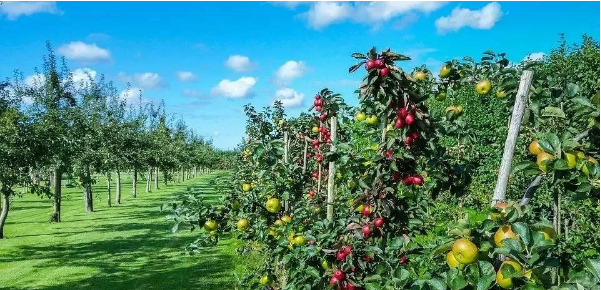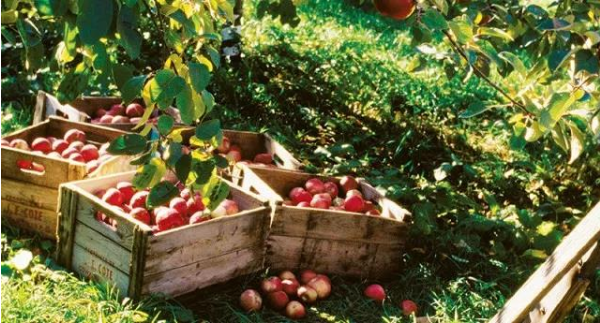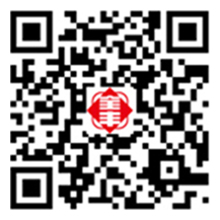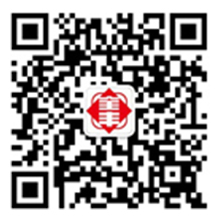A Complete Collection of Fertilization Techniques -- About Fertilization of Fruit Trees
Time:2023-01-30 Follow:926

Mistake 1: The closer the fertilization point is to the tree, the better.
Many fruit growers believe that fertilization is far away from the tree, the root absorption is poor, and the nutrient utilization is not good. Therefore, fertilization is very close to the tree, and some are less than half a meter from the root neck, and even dig out the backbone root. As a result, the phenomenon of root injury and root burning often occurs, and the effect has always been contrary to expectations.
Mistake 2: The more fertilizer, the better.
Some fruit farmers do not comprehensively determine the amount of fertilizer according to the type of fertilizer, the strength of the tree, the size of the tree, the amount of yield, the soil conditions and other factors, but blindly, thinking that the more the amount of fertilizer, the better. The result is that the supply and demand of tree nutrition are unbalanced, the heavy ones burn roots and die trees, diseases and pests breed, the light ones are unbalanced in nutritional growth and reproductive growth, and only trees grow, with little or even no fruit.

Mistake 3: Fertilization time is busy.
Some fruit farmers apply fertilizer not according to the time when the fruit trees need fertilizer, but according to the time when the labor is busy. "When the trees need fertilizer, there is no time to apply fertilizer, and when the people are idle, the trees do not need fertilizer." What should be fertilized in spring becomes summer fertilization, and what should be fertilized in autumn becomes winter fertilization. The pre-flower fertilizer that should be applied becomes post-flower fertilizer, and the post-flower fertilizer becomes post-fruit fertilizer, which missed the better fertilizer demand period of the fruit trees, and the yield increase effect is greatly reduced.
Mistake 4: The more fertilizer, the better.
The autumn application of base fertilizer in orchards coincides with the autumn sowing of wheat fields. Many fruit farmers use chemical fertilizer to replace the base fertilizer at will, or use uncooked crop straw to replace farm manure and other farm manure. This has been the case for years. As a result, the orchard fertility has declined, the tree vigor has weakened, the yield has decreased, and the fruit quality has deteriorated.

Five misunderstandings: underground fertilization is more important than ground fertilization.
Many fruit farmers are accustomed to underground fertilization, and despise or fail to understand the role of aboveground fertilization, namely, foliar fertilizer spraying, which leads to serious physiological diseases such as yellow leaf disease, small leaf disease, fruit shrinkage disease, early defoliation disease and reduced leaf photosynthetic function.
Where is the best place to fertilize fruit trees?
To apply fertilizer to fruit trees, first of all, we should know that fruit trees are mainly completed by root hairs in the root system; The topdressing of fertilizer for fruit trees should be based on the edge of the crown projection or a little distance, and should not be too close to the trunk, because there are thick roots near the trunk, and there are fewer fine roots and root hairs, which is not conducive to the absorption of fertilizer.

The depth of fertilizer application for fruit trees should be in accordance with the following principles: fruit trees with deep root distribution should be applied deeply, and vice versa; The decomposition of organic fertilizer is slow, but the fertilizer supply period is long, which can be applied deeply, and the mobility of chemical fertilizer is large, which can be applied shallowly; For example, for deep-rooted fruit trees such as pear trees, the depth of organic fertilizer should be 40-60 cm, while for shallow-rooted fruit trees such as plum trees, the depth of organic fertilizer should be 30-40 cm. Spraying new high-fat film after fertilization can improve fertilizer efficiency.
Top dressing fertilizer for fruit trees. For closed or densely planted orchards, shallow application can be applied between rows and trees, so as not to damage or less damage the big roots, so as to give full play to fertilizer efficiency, improve fertilizer utilization rate, and achieve the purpose of increasing production and income.
1. Choose fertilizer according to "appetite"
Generally speaking, fruit tree fertilization is like eating, and the fertilizer maker is equivalent to a cooking master. If a certain kind of fertilizer is applied too much or too little, and the "appetite" is turned off, the tree will be in a "sub-healthy" state, such as weak or weak. Total nutrient balanced fertilization should focus on supplementing the organic matter, medium and trace elements seriously lacking in the orchard to create a good site condition for root growth. Because organic fertilizer is the "passbook" of soil, it plays an important role in fertile soil, root cultivation and improving the utilization rate of fertilizer.
The organic fertilizer is better to use decomposed pure chicken manure, sheep manure, oil cake and biogas manure, followed by pig manure, cow manure and farm soil manure. When manure is short or not yet decomposed, it can also be replaced by organic bacterial manure.

The fertilizer should be reasonably formulated according to the needs of different varieties of fruit trees for different nutrients. Through a large number of field experiments, the reasonable ratio of nitrogen (N), phosphorus (P2O5) and potassium (K2O) of different fruit trees was determined as follows: apple 1:0.6:1, grape 1:1.41:1.25, pear 1:0.21:1.02. It should be emphasized here that although the growth and development of apples and pears throughout the year have a "high - medium - high" demand for "nitrogen, phosphorus and potassium", the basic fertilizer applied in autumn should be applied to more than 80% of the total amount of phosphorus fertilizer throughout the year, because autumn is the peak period of root growth throughout the year, and phosphorus is the rooting nutrient, which is supplied steadily throughout the year.
2. Fertilization should be done at "meal time"
The same meal makes people feel comfortable. When you miss a meal, you feel tasteless. Autumn is at the peak of root growth of fruit trees throughout the year. The nutrients absorbed and synthesized by the roots are mainly used for storage, which plays an important role in budding, flowering, fruit setting and shoot growth in the coming year. Therefore, the same fertilizer applied from September to October is as valuable as gold and silver; After falling leaves and next spring, it will depreciate to the value of copper and iron.

3. Fat should be fed in the mouth
People eat by mouth, trees eat by root, and the mouth of the root is at the tip. Applying fertilizer to the concentrated distribution layer of the fruit tree's absorption root is beneficial to the root absorption. In general, 80% of the absorbing roots of fruit trees such as nuts and drupes are mainly distributed in the 10-50 cm soil layer under the vertical projection of the outer branches of the tree crown, which requires that 80% of the total amount of fertilizer should be applied in this area. Young trees and early bearing trees are better applied by circular expansion. Trees in full fruit stage can use the method of alternate application of radial ditch application and whole garden spraying.
4. Borrow moisture and fertilize "don't eat dry"
If the soil moisture is not good, the root system will still be unable to absorb the fertilizer. Because all kinds of chemical fertilizers applied to the soil have no life and will not move. Only when they are dissolved in water, can they be absorbed and utilized by roots and leaves. At the same time, the amount of nutrients absorbed and accumulated by fruit trees in the same year is also closely related to the transpiration pull of some aboveground branches and leaves. Taking advantage of the advantages of large transpiration pull and good moisture content of leaves in early autumn, the transpiration of leaves can absorb a large amount of water and nutrients from the ground after fertilization, and the nutrient accumulation of trees will be more. Otherwise, no matter how high the effective content of fertilizer is, it cannot be dissolved in water and has no functional leaves, fertilizer will become a piece of junk metal that is not worth looking at. This is the reason why fertilizer should not be eaten dry.




